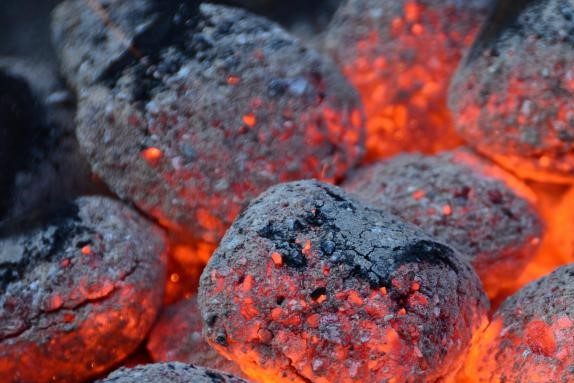Since camp Dutch ovens are used for cooking over hot coals you’ll need some gear to safely cook and manage the cooking temperature. Whether you are cooking over a campfire or using charcoal briquettes the gear is similar. The big difference is that cooking over a fire is often done with a tripod or other device to suspend the Dutch oven over the fire and cooking with charcoal briquettes is usually done with the camp Dutch oven sitting on a cook table. This site is focused on gear needed to cook with charcoal briquettes.
What to Look for in a Cook Table
When shopping for a cook table, try to find one that meets the criteria listed below. Some of the items listed are not absolutely necessary, but the more items you can check off on this list, the better the table will be.
- It needs to be inflammable and able to withstand the anticipated heat. If you start your charcoal with a propane torch, the table will be subjected to much higher heat from the propane flame than it will from charcoal.
- The table should be large enough to accommodate your Dutch ovens with enough space around the ovens to allow you to add and remove coals. If more than one oven is on the table there needs to be adequate distance between the ovens. Otherwise, the heat from the coals of one oven may increase the temperature of a nearby oven and vice versa.
- The table needs to be a good height so that you can comfortably place and remove your ovens and easily remove and replace oven lids and charcoal.
- The size and weight must be such that you can easily transport and set up the table. And it helps to have a carrying handle that is located with equal weight on each side of the handle.
- The table should accommodate an effective windscreen. An effective windscreen is one that stays put and is tall enough to screen the wind.
- It is nice to be able to sweep ashes off of the surface of the table. Some tables are constructed to accommodate this while others require a dustpan or coal shovel for removing ashes.
- Having shelves attached to the oven will provide a place to set ovens, lids, coal chimney, etc. Hangers are nice for keeping your tongs, coal shovel, and lid lifter handy.
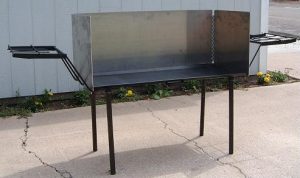 There are several cook tables on the market and many homemade cook tables that work just as well or better than commercial cook tables. One of the best tables and one that meets all of the criteria mentioned above is sold at Chuck Wagon Supply. Their table is sturdy, easy to set up, and has a tall windscreen that is easy to attach. It comes with shelves that attach to each end. The table, windscreen, and shelves all fit into a canvass carrying bag that is sold with the table.
There are several cook tables on the market and many homemade cook tables that work just as well or better than commercial cook tables. One of the best tables and one that meets all of the criteria mentioned above is sold at Chuck Wagon Supply. Their table is sturdy, easy to set up, and has a tall windscreen that is easy to attach. It comes with shelves that attach to each end. The table, windscreen, and shelves all fit into a canvass carrying bag that is sold with the table.
Cook Table Maintenance
Cook tables are made of metal and, other than cleaning, require little active maintenance. Wet ash is acidic, so it’s a good idea to remove the ash from the table before it gets wet. Unless the table is galvanized or has a good rust resistant paint it will rust, so keep it dry and it should last for years.
Quality Charcoal Briquettes
Our objective when using charcoal briquettes is to control the temperature in the Dutch oven as accurately as possible. Dutch oven temperature is primarily affected by ambient temperature, wind, humidity, and the amount of heat emitted by the briquettes. You can’t control the weather, but you can choose good quality briquettes. The quality of briquettes is defined by 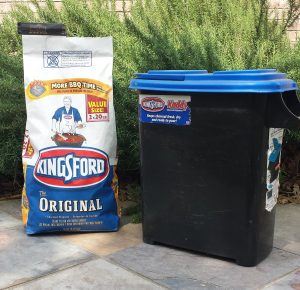 their ability to consistently emit a specific amount of heat. Some brands are better at this than others. When you find a brand that works for you stay with it because the amount of heat emitted will vary from brand to brand. I use Kingsford Original charcoal briquettes.
their ability to consistently emit a specific amount of heat. Some brands are better at this than others. When you find a brand that works for you stay with it because the amount of heat emitted will vary from brand to brand. I use Kingsford Original charcoal briquettes.
Some brands make briquettes that light with a match or have various types of wood embedded in them. It is okay to use these, but they generally cost more than plain briquettes and add little if anything of value when using them for Dutch oven cooking.
Charcoal must remain dry. If it ever gets wet it will not burn as hot even after it dries out. It’s best to store charcoal bags in a dry environment and transfer the charcoal to a waterproof container after the bag is opened.
How Many Briquettes to Use
The amount of charcoal needed for Dutch oven cooking varies with the desired cooking temperature and the size of the oven. As previously mentioned the brand of charcoal may come into play when determining how much charcoal to use. And of course, the weather will play a role. There’s several websites with guides on controlling camp Dutch oven temperature using charcoal briquettes. One that I like is at Dutch Oven Net. Smartphone apps are also available.
I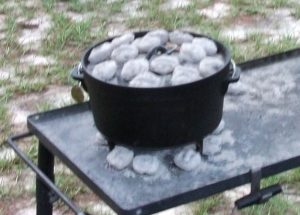 employ the “3-up-3-down” rule to determine the number of briquettes I use. This rule is simple, but like all rules for controlling temperature in a camp Dutch oven, it is only a guide. The rule must be employed with the understanding that the actual number of briquettes needed will depend on the weather, the brand and type of briquettes used, and the cook table or environment near the camp Dutch oven.
employ the “3-up-3-down” rule to determine the number of briquettes I use. This rule is simple, but like all rules for controlling temperature in a camp Dutch oven, it is only a guide. The rule must be employed with the understanding that the actual number of briquettes needed will depend on the weather, the brand and type of briquettes used, and the cook table or environment near the camp Dutch oven.
The 3-up-3-down rule says:
- for an internal oven temperature of 325 degrees F (163 degrees C), the number of briquettes on the lid should be three plus the oven diameter and the number of briquettes under the oven should be the oven diameter minus three.
- for every 25 degree F (12 degrees C) increase in temperature add one briquette to the top and one briquette under the oven.
- for every 25 degree F (12 degrees C) decrease in temperature remove one briquette from the top and one briquette from under the oven.
For example, for 400 degrees F (204 degrees C) using a 12-inch Dutch oven:
- place 12 + 3 + 3 = 18 briquettes on the lid,
- place 12 – 3 + 3 = 12 under the oven.
And remember, when you are baking, the bottom coals should be placed near the edge of the oven not directly under the oven.
Gloves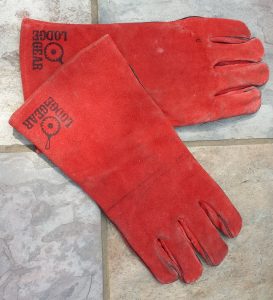
Handling a hot Dutch oven is somewhat like welding in that your hands are going to get burned if you don’t wear good gloves. Some are more comfortable than others, but otherwise any heavy leather gloves that extend to cover your wrists will do.
Charcoal Chimneys and Charcoal Starters
Charcoal chimneys come in various sizes, shapes, and configurations. Unless you have a 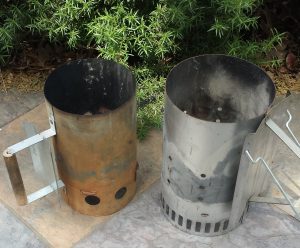 propane torch or some other way to light charcoal, a charcoal chimney is worth the investment. Briquettes are placed in the chimney with a little newspaper or a charcoal starter under the chimney. The flame from the paper or starter will light the bottom briquettes and the heat will rise and draw air into the chimney. This is a quick and efficient way to get hot coals in about 15 minutes.
propane torch or some other way to light charcoal, a charcoal chimney is worth the investment. Briquettes are placed in the chimney with a little newspaper or a charcoal starter under the chimney. The flame from the paper or starter will light the bottom briquettes and the heat will rise and draw air into the chimney. This is a quick and efficient way to get hot coals in about 15 minutes.
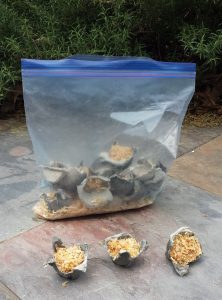 Charcoal starters can be made using cardboard egg cartons, wax, and flammable filler such as wood shavings, dryer lint, etc. The filler is placed in the egg carton compartments and a little hot wax is poured over it. The compartments can then be separated. These starters work well for starting charcoal briquettes and are fun and inexpensive to make.
Charcoal starters can be made using cardboard egg cartons, wax, and flammable filler such as wood shavings, dryer lint, etc. The filler is placed in the egg carton compartments and a little hot wax is poured over it. The compartments can then be separated. These starters work well for starting charcoal briquettes and are fun and inexpensive to make.
Coal Shovels and Tongs
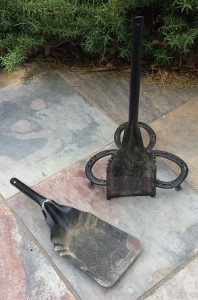 Any small shovel, like one you use for your fireplace, will work for managing coals. And tongs are needed to place coals under and on top of your Dutch oven. These frequently used tools need to be readily accessible so its nice to be able to hang them on your cooking table.
Any small shovel, like one you use for your fireplace, will work for managing coals. And tongs are needed to place coals under and on top of your Dutch oven. These frequently used tools need to be readily accessible so its nice to be able to hang them on your cooking table.
Lid Lifters
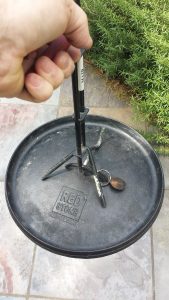 There are various types and sizes of lid lifters. Its best if your lid lifter will allow for removal and placement of the lid without the potential for tipping and loosing hot coals and ash. A little ash in your food is no big deal; a bunch of coals and ash in your food is not desirable. Here’s a link to a lid lifter that is reasonably priced.
There are various types and sizes of lid lifters. Its best if your lid lifter will allow for removal and placement of the lid without the potential for tipping and loosing hot coals and ash. A little ash in your food is no big deal; a bunch of coals and ash in your food is not desirable. Here’s a link to a lid lifter that is reasonably priced.
Windscreens
Commercial Dutch oven tables are generally sold with a windscreen. Some of these are short and ineffective at screening the wind. An effective windscreen can be made 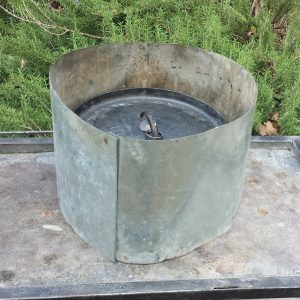 using galvanized or aluminum flashing. Flashing comes in rolls that are typically 10, 14, or 20 inches in width although other widths are available. Common roll lengths are 10, 25, and 50 feet. You can find these at stores that sell building materials. I buy mine at Home Depot. A WORD OF CAUTION – the edges of roof flashing are sharp and pose a hazard. Attach high heat tape to the edges to reduce the potential of being cut. The edges of the windscreen shown here could use some tape.
using galvanized or aluminum flashing. Flashing comes in rolls that are typically 10, 14, or 20 inches in width although other widths are available. Common roll lengths are 10, 25, and 50 feet. You can find these at stores that sell building materials. I buy mine at Home Depot. A WORD OF CAUTION – the edges of roof flashing are sharp and pose a hazard. Attach high heat tape to the edges to reduce the potential of being cut. The edges of the windscreen shown here could use some tape.
Lid Stands
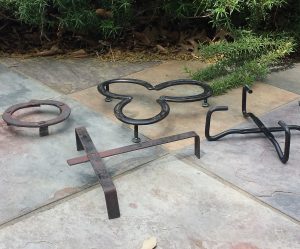
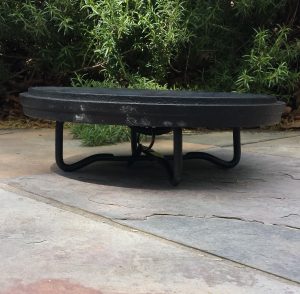 Dutch oven lids have a loop handle in the center of the lid. When serving food on the lid, a lid stand is needed that will stabilize the lid and allow it to remain horizontal. The lid stand can also be used as a trivet for the camp Dutch oven. Lid stands are commercially available but homemade lid stands are quite common. Walmart and others offer Lodge lid stands like the one shown here supporting a lid.
Dutch oven lids have a loop handle in the center of the lid. When serving food on the lid, a lid stand is needed that will stabilize the lid and allow it to remain horizontal. The lid stand can also be used as a trivet for the camp Dutch oven. Lid stands are commercially available but homemade lid stands are quite common. Walmart and others offer Lodge lid stands like the one shown here supporting a lid.
